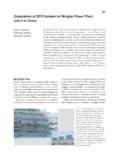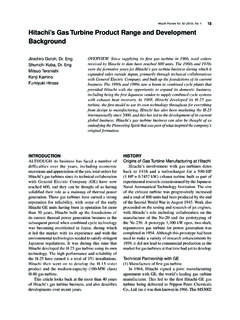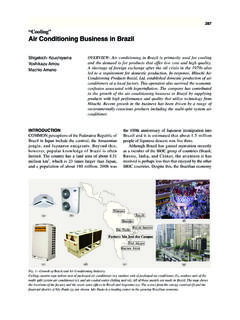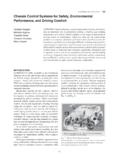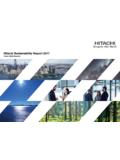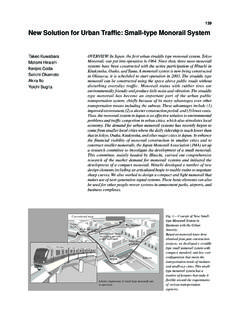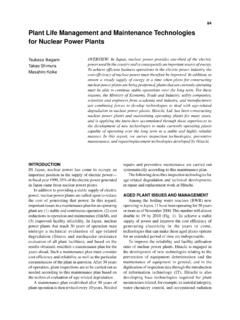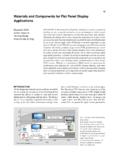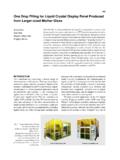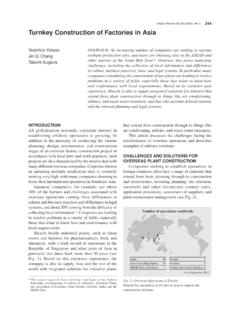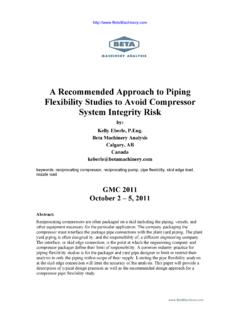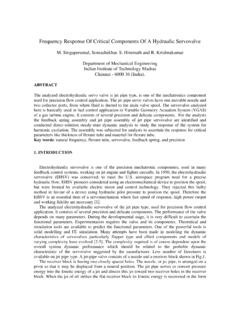Transcription of Titanium 50‑inch and 60‑inch Last‑stage Blades for …
1 Hitachi Review Vol. 62 (2013), No. 1 23 Titanium 50 inch and 60 inch Last stage Blades for Steam TurbinesShigeki Senoo, , AsaiAtsuhiro KurosawaGoingwon LeeOVERVIEW: Hitachi has developed 3,600 r/min 50 inch Blades and 3,000 r/min 60 inch Blades as last stage buckets for steam turbines with some of the largest annulus areas in the world. Adopting these Blades for use in a 1,000 MW class steam turbine provides benefits that include improving turbine efficiency in relative terms by approximately over that of steam turbines using 40/48 inch last stage buckets, and increasing reheat steam temperature from 600 C to 620 C.
2 In response to the problem of supersonic inflow at the tips of the buckets, supersonic turbine Blades were developed to reduce loss, and the fluid performance of these Blades was verified through cascade tunnel testing. In addition, a Titanium alloy with a high specific strength was used to keep the centrifugal stresses in both blade and rotor within allowable limits. The 50 inch Blades that were developed will be used in the 1,050 MW ultra supercritical pressure steam turbines in units No. 9 and No.
3 10 at Korea Western Power Co., Ltd. s Tae An Thermal power turbines are used in various types of power generation including coal-fired power generation, gas turbine combined-cycle power generation, nuclear power generation, and other power generation systems. Together, they provide the world with more than 60% of its electric power. The world s demand for electric power will continue increasing as the population grows and standards of living improve in developing economies, with demand predicted to reach approximately times that of 2009 in the year 2030, and approximately in the year 2050(1).
4 As a result, along with the expanded use of renewable energy, there is also a demand for increases in the amount of electric power generated by steam turbines. In particular, coal-fired power generation is important because coal reserves are plentiful and there is not much imbalance in amounts from region to region, so coal-fired power generation can be effectively the other hand, from the perspective of environmental compliance, it is necessary to improve the efficiency of steam turbines in order to reduce carbon dioxide (CO2) emissions.
5 The average gross thermal efficiency of the world s coal-fired power plants is approximately 33% (lower heating value standard, 2009), and by replacing the turbines in these plants with Hitachi s new ultra-supercritical pressure*1 steam turbines with efficiency greater than 45%, it will be possible to reduce CO2 emissions by more than 30%.Fig. 1 3,600 r/min 50 inch Last stage an annulus area among the largest in the world*2, turbine efficiency is improved by reducing wasted kinetic energy.
6 *1 Steam conditions with temperature at 593 C or higher and pressure at MPa or higher.*2 Based on research into publically available information as conducted by Hitachi, Ltd. Current as of September 50 inch and 60 inch Last stage Blades for Steam Turbines 24 This article discusses technologies used to increase the efficiency of steam turbines, and in particular, the development of Titanium 50- inch (see Fig. 1) and 60- inch last- stage OF 50/60 inch LAST stage BLADESM easures taken to improve the efficiency of a 1,000-MW class steam turbine include, but are not limited to, lengthening the last- stage buckets (moving blade ), increasing the reheat steam temperature, optimizing reaction degree, increasing the number of stages, adopting a new seal construction that reduces gaps, developing an advanced vortex nozzle (AVN) ( nozzle is a stationary blade )
7 , and improving the pressure recovery effect of the exhaust hood (see Fig. 2).The last- stage blade Hitachi developed is a 50- inch blade with one of the largest annulus areas in the world (the area of the blade s circular ring part, where the flow passes through), for use in 3,600 r/min turbines, as well as a 60- inch blade with a similar design for 3,000 r/min turbines (see Table 1)(2). Although some of the kinetic energy emitted from the last- stage is used by the exhaust diffuser to recover pressure, most of it cannot be extracted as power, and is lost.
8 By increasing the size of the annulus area, decreasing the axial velocity of the last- stage outlet, and reducing Coal-fired thermal powerCoal-fired thermal powerTCDF-30 HIP integrated type(two-cylinder) integrated type(two-cylinder)HIP integrated type(two-cylinder)HIP integrated type(two-cylinder)HIP integrated type(three-cylinder)HIP integrated type(three-cylinder)HIP integrated type(three-cylinder)HP/IP separate type(four-cylinder)HP/IP separate typeHP/IP separate type(four-cylinder)HP/IP separate type(four-cylinder)HP/IP separate type(four-cylinder)(four-cylinder)60 Hz3,600 r/min50 Hz3,000 r/minTCDF-40 HIP integrated type(two-cylinder)TCDF-43 TCDF-45 HIP integrated type(two-cylinder)TCDF-48 HIP integrated type(three-cylinder)TC4F-40 HIP integrated type(three-cylinder)TC4F-43 HIP integrated type(three-cylinder)TC4F-48HP/IP separate type(four-cylinder)TC4F-43HP/IP separate type(four-cylinder)TC4F-48TC4F-30 HIP integrated type(three-cylinder) integrated type(two-cylinder)TCDF-60 (Ti)
9 (Ti)1,4001,2001,0008006004002001,4001,20 01,000800600400200 Output(MW)Output(MW)TC4F-60 (Ti) 3 Output Lineup of Steam Turbines for Use in Coal fired Power Generation, Based on Turbine Type and Last stage blade 50 inch and 60 inch Blades are used in 1,000 MW class output steam turbines with low pressure turbines and two cylinders (four flows).TC4F-50: TC (tandem compound) high-pressure, intermediate-pressure, and low-pressure turbines are all connected along a single axis. 4F means the number of last- stage flows, with 4F meaning four-flow and DF meaning two-flow.
10 -50 = length of last- stage buckets. Ti: titaniumHIP: high and intermediate pressure turbine HP: high-pressure turbine IP: intermediate pressure turbineParameter50 inch 60 inch Rotational speed3,600 r/min3,000 r/minBlade length1,250 mm1,500 mmAnnulus m2 Boss ratio ( blade inner diameter/ blade outer diameter) tip speed 786 m/sBlade materialTi-6Al-4V alloyTABLE 1. 50/60- inch Last- stage blade SpecificationsThe annulus areas are among the largest in the world, and a Titanium alloy is used to reduce centrifugal 2 Measures for Improving Efficiency of 1,000 MW Class Steam is improved for steam condition, Blades , seals, and exhaust hoods.
